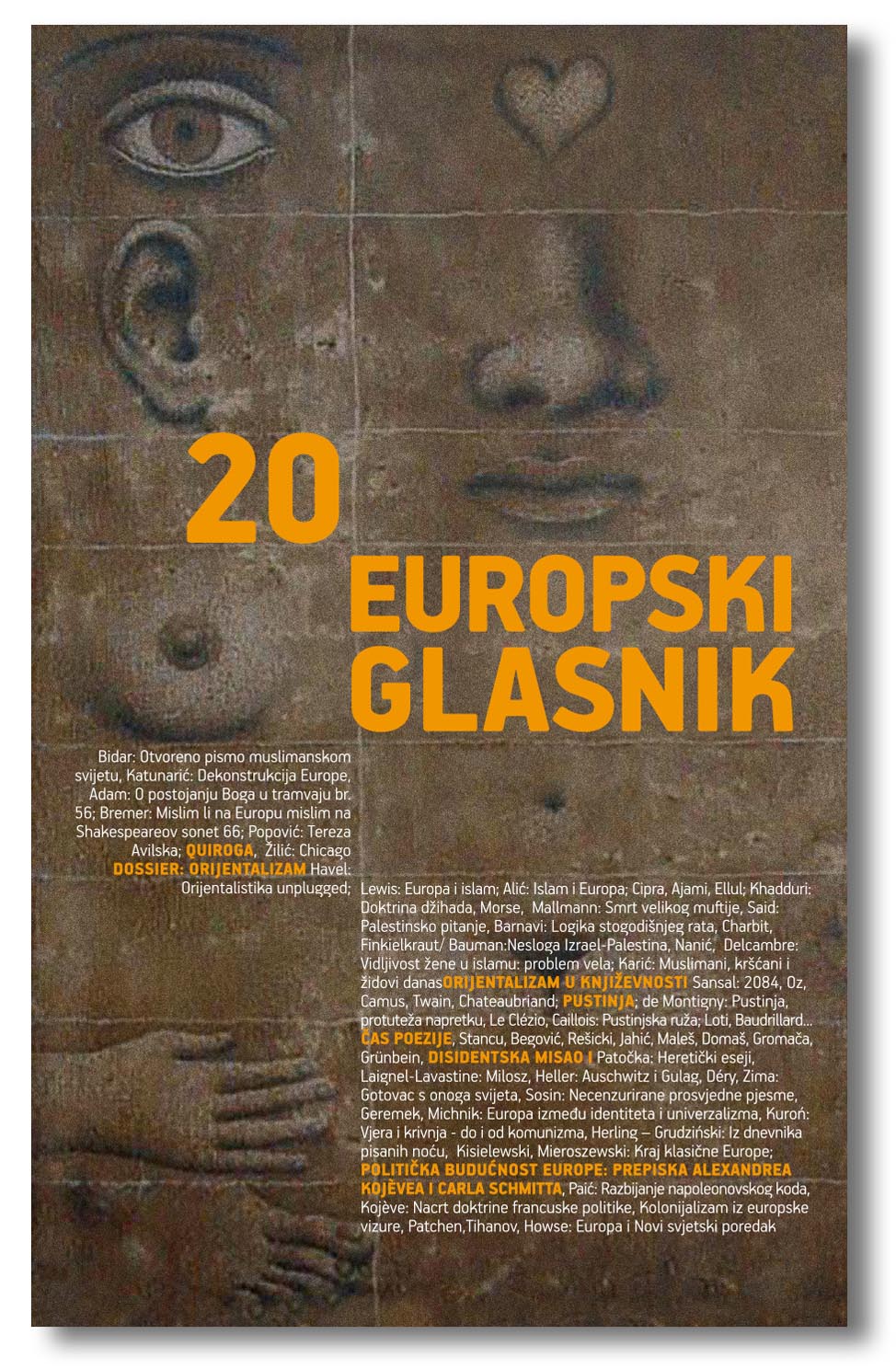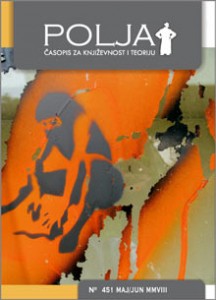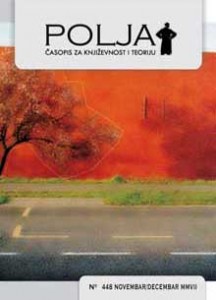
We kindly inform you that, as long as the subject affiliation of our 300.000+ articles is in progress, you might get unsufficient or no results on your third level or second level search. In this case, please broaden your search criteria.


Neka čitatelj ne misli da je ova priča istinita i da se služi nekom poznatom stvarnošću. Ne, stvarno, sve je izmišljeno, osobe, činjenice i ostalo, a dokaz je taj što se priča odvija u dalekoj budućnosti, u daleku svemiru koji ni po čemu ne sliči našem.
More...
Dans l’appartement de Véra et Baba les bruits se mouraient, l’un après l’autre. On n’entendait plus le programme radio matinal, ni le battement des casseroles ou de l’attendrisseur. La discussion véhémente sur des recettes pour la préparation du brudet s’est réduite au silence, tout comme celle concernant le fromage allant avec le risotto aux pinnes. Des tziganes et Miles Davies ont vidé leurs trompettes. Des concerts du samedi pour l’aspirateur et l’orchestre (Baba soutient qu’on aspire mieux quand on est accompagné de la Marche de Radetzky) ont été annulés. La chasse d’eau n’était plus aussi bruyante qu’auparavant, les robinets ne témoignaient plus de fuites. De leur appartement n’arrivait plus qu’un sifflement humain assourdi, ainsi qu’un bourdonnement spectral du téléviseur. Comme disait ce mec : l’amour est éternel jusqu’au mariage. Ensuite il perd de la couleur, de l’odeur et du goût, se transformant en une série de situations comme la suivante.
More...
Čudan je to osećaj da vam pripadaju sudbine gostiju koji su odabrali da baš u vašem hotelu provedu noć. Nazvao sam ga hotel „Strepnja“. Hotel „Strepnja“ sa milion zvezdica. Bio je to hotel u kome se sobe iznajmljuju na jednu noć. Hotel za prolaznike, smešten u vremenskoj pukotini, u izgubljenom prostoru. Ja nisam tužan čovek. Niti sam od onih koji neguju strahove da bi ugađali sopstvenoj malodušnosti. Nisam ni previše sujetan. Moguće je da sam, pomalo, tek koliko je to neophodno, melanholičan. Ne volim tu reč, mada sam, nekada, u bivšem životu, napisao nekoliko knjiga poezije koje su nazvane melanholičnim. Bilo je to u doba kada je Dinastija ratovala, Dinastija koja je sada duboko u prašini, na đubrištu, ali čiji tragovi mogu da se prepoznaju u novinama, govoru ljudi, ponekad i u načinu odevanja. Dinastije ne nestaju onda kada vladari budu svrgnuti ili pogubljeni. Dinastije su palimpsesti.
More...
Sa pedeset godina otišao sam da živim sâm na Suvarovu i to posle trideset godina lutanja Pacifikom; u ovoj priči ću nastojati da opišem svoja osećanja, da rečima iskažem ono što je za mene bilo najznačajnije i najvrednije iskustvo celog mog života.
More...
Ako pogledam istočno od svoje kuće iznad jezera Šamplen, mogu videti četiri od najmanje obećavajućih ostrva koje možete zamisliti. Zovu ih „Četvoro braće”, a uglavnom su to sive hridi, stenovite plaže i skeletno drveće koje su galebovi i kormorani očerupali do golih grana. Ali iz načina na koji ta ostrva uzbuđuju ljude, pomislili biste da su Maui, Mikonos, Tahiti i Kapri.
More...
Ubeđen sam da me je otac pogledao – da me je stvarno video – samo jedanput. Posle toga, znao je sa čime ima posla. U ta vremena, očeve nisu puštali u blistave sale u kojima su se rađale bebe, niti u sobe sa ženama koje će uskoro da se porode, dok u sebi prigušuju jecaje ili pate na sav glas. Očevi bi pogledali majke tek kada bi njih, oprane, svesne i ušuškane u ćebad pastelnih boja, premestili u bolničke sobe ili u privatne boksove.
More...
Lađu su nosili talasi, jer se veslači behu sklupčali na svojoj klupi, opijeni, ali ovoga puta od umora. I to zbog toga što je trojanska gozba trajala dvadeset godina. Žalili su se, najtiše što su mogli, žvaćući komadiće užadi da zavaraju glad i žeđ, no bili su odlučni da se u svom životu više ne maknu. A onda je lukavi Odisej naložio Perimedu da zatrubi za ručak i svi su poleteli, izuzev Elpenora, koji je od Lotofaga poprimio običaj da puši, a beše bačen negde u potpalublje...
More...
Sećam se jednog divnog jutra, plavetnog i srebrnog, kada sam teška srca prekinuo svoje uobičajeno letnje lenčarenje, natukao šešir, uzeo palicu i stavio u džep šest kreda jarkih boja. Onda sam otišao u kuhinju (koja je, kao i cela kuća, pripadala poštenoj i razumnoj ženi u jednom selu u Saseksu), i upitao gazdaricu ima li pakpapira. Imala ga je u velikoj količini ali je pogrešno shvatala njegovu namenu.
More...
Shuttling between the old world and the new world both culture- andarchetypology-wise, the contribution at hand aims to ferret out the similaritiesand contrasts woven into the rich tapestry of Asuntos de un hidalgo disoluto,through which the Columbian novelist Héctor Abad Faciolince is carefullythreading the following different heroic typologies: the picaresque, thecandidesque and that represented by the chief male character of the novel underscrutiny. Firmly grounded in the analysis of said similarities and contrasts, theidiosyncratically fashioned protagonist will then emerge not merely as acoalescence of the typologies in question, but also, paradoxically enough, insharp contrast, or, on occasion, as a perfect complement or even correctivethereto. The paper further seeks to shed light on the continual shift of theColumbian (anti)hero from candid- to picaroon-like stances, with an additionalfocus placed on memorizing, remembering and consigning to oblivion, and,more importantly even, on the intertextual dialogue which these techniques areorchestrating between authors, continents, ages and cultural heritages.
More...
In the introduction to the book In Reel Food: Essays on Food and Film, Anne Bower discusses, among other, the food film genre, stating that one of the conventions of this genre refers to the ways in which the characters negotiate “questions of identity, power, culture, class, spirituality, or relationship through food” (6). Chocolat, the 2000 movie adaptation of Joanne Harris’ novel (1999), revolves around the changes brought about by Vianne Rocher, the owner of a chocolaterie, in the small French community of Lansquenet, in 1959, and illustrates the culture and gender clashes between Vianne and the Comte de Reynaud, the male authority of the community. By examining the significance and impact of the two main discourses - of resistance to temptation and repression, on the one hand, and of acceptance and tolerance, on the other - this essay looks at the underlying issues of identity, gender, and difference in the male-dominated (church) and femaleinhabited (the chocolaterie) private and public spaces of the Lansquenet community.
More...
Studies in Victorian literature have tended to regard gossip as a form of social talk without considering its significance as a social interaction that communicates information in fictional societies. This article takes a different approach and examines the novel, Tess of the d’Urbervilles, as a case study. Using contemporary research on the sociology of gossip, rumours, legends and scandal, it attempts to understand the function and importance of these various forms of social judgement utilized by Thomas Hardy in his novel. Thispaper argues that the informal circuitries of information greatly influence the plot and Tess’s decisions and eventually lead to her tragedy. Furthermore, this study of gossip in fiction adds to the existing literary criticism of novels in Victorian literature, and prompts that gossip’s unacknowledged and varied role in literature should be assessed in future research.
More...
This paper discusses the historical novels Der Grosse Schwabenzug by Adam Müller Guttenbrunn (1852-1923) and Der Werschetzer Tat by Karl von Möller, as well as the monumental painting Die Еinwanderung der Schwaben in das Banat by Stefan Jäger (1877-1962). These works of art appeared in the early XX century, when the Danube Swabians went through a belated national awakening and began to organise politically. The novels, particularly Guttenbrunn’s, experienced huge popularity and several editions with large print runs, while the painting’s reproductions, both in cheap and expensive versions, arrived into many German homes and public buildings. That is how the German colonisation of Pannonia was integrated into the widespread myth of the “age of heroes” (Heldenzeitalter) – as the patriotic historians called the historical period of the Hapsburg monarchy from the late XVII to the mid-XVIII century. The role of Danube Swabian settlers was overestimated and they were represented as the vanguard of the Western civilisation and the progressive force in Southeastern Europe. That stereotype was a key influence on the formation of the particular collective identity of this branch of the German nation.
More...


‘Shaped like the Island of Newfoundland’: The Japanese Influence on Pilgrimage in John Steffler’s The Grey Islands” explores the impact of John Steffler’s long-time obsession with Japanese literature and of the underlying Shinto and Buddhist philosophies on his poetry. In examining the poetry and journey of The Grey Islands, this essay shows the various ways in which the Japanese literature and philosophy have influenced the poetic representations of the relationship between man and nature, how they shaped the poet’s awareness, use of stillness, and infused his work with continual reminders of impermanence, thereby allowing for an altered sense of time and the supernatural, as well as legitimizing his travel and retreat to the Grey Islands. These very Japanese components of Steffler’s vision intersect in interesting ways with the geographical place of Newfoundland in his work. Moreover, there are many ways of viewing Steffler’s journey of The Grey Islands as a pilgrimage, but this paradigm is necessarily changed by the shape of Newfoundland and the influence of Eastern thought.
More...
Seymour Glass, the main character of J.D. Salinger’s Glass family stories, would be a potential poet if it had not been for his early suicide. In “Seymour: An Introduction,” his brother Buddy Glass writes about Seymour’s poems and the universe of literature, at the same time as he evokes childhood memories. However, Seymour’s poems are never shown to the reader of “Seymour: An Introduction;” they are kept in Buddy’s hands and in the readers’ imagination. They are invisible poems that Buddy uses in an attempt to legitimate Seymour’s brilliant existence in the Western reality. The poems, as Buddy suggests, are in haiku form – Japanese poetry. Seymour constantly builds a bridge between Eastern and Western cultures (in relation to religion, literature, philosophy), and this is done through Buddy’s narratives about his family, the Glass family. Jack Kerouac and some writers from the beat generation also incorporated the Eastern culture in their works, especially regarding religion. Some of them, including Kerouac, studied Buddhism and found in the Eastern religion and literature a way to escape the socio-political struggles the U.S. was facing during the 1960s. Bearing that in mind, it is relevant to ask: How do J.D. Salinger and Jack Kerouac develop an argument in their works regarding the appropriation of Eastern religion and literature in the U.S. 1960s culture? Thus, this essay aims at discussing such questions based on Roland Barthes’ book Empire of Signs, in order to understand the bridge Salinger and Kerouac built between Eastern and Western cultures during the long 1960s.
More...
In her last novel, Daniel Deronda (1876), George Eliot demonstrates a profound, if uneven relationship between the traditions of the English upper classes and the culture of European Jews. Through the novel’s two principle characters, Daniel Deronda and Gwendolen Harleth, Eliot grounds her broader cultural dichotomy in the intimate relationship between two people who share an unusual experience of chance. Over the course of the novel, Eliot explores the chance nature of Daniel’s identity – his native Jewishness and his English nature – as well as Gwendolen’s misfortunes, which force her to undergo a profound test to her nature and represent for Daniel a mirroring of his own mother’s experience of oppression in marriage. Eliot explores identity, though, with an emphasis on the broader cultural differences that inform the characters’ positions. Although some critics and readers have questioned the compatibility of the more distinctly English elements with the Jewish plot lines, the aim of this essay is to demonstrate the significance of the dichotomy between the novel’s two plots and, more generally still, its two divergent cultural perspectives.
More...
Published in 2012, Home by Toni Morrison brings into discussion some of the problems which the African-Americans of the 1950s confronted, and it concentrates, in less than 150 pages, on the destinies of two brothers, Frank and Ycidra Money, from Lotus, Georgia. Morrison’s style is direct, concise, accessible and heartwarming. The two concepts upon which I have concentrated throughout the novel are “otherness” and “change,” both of them showing the development of the protagonists’ personalities, as well as how they can influence the lives of the main characters.
More...
At the beginning of the twenty-first century, many Western tourists have become interested in visiting Transylvania, a region in the central part of Romania, in Eastern Europe, in order to discover the stories and legends about Count Dracula, a mysterious and ruthless vampire, who, some believe, might have inhabited various solitary places in the heart of Transylvania. Some of these tourists may know that the Dracula vampire story originated in a novel written by Bram Stoker, who placed the vampire in Transylvania, a faraway mythic space, and the legends woven around this fictional character have created an intriguing link between the vampire figure and a real-life, fifteenth-century Romanian ruler, Vlad Ţepeș/Dracula. As a result of Western media representations of the Dracula myth, in time, Romania has acquired (and developed) a connection with the vampire myth. Therefore, this paper sets out to examine the impact of the Dracula myth on the postcommunist society, by exploring the historical and cultural dimensions of the “Dracula connection,” reflected in the dichotomy between the Romanian general perception about Vlad Dracula as a medieval ruler and “the other” Romanian version of the Dracula vampire ersona loosely based on Vlad Dracula (a version constructed for a Western “audience” for commercial and touristic purposes).
More...